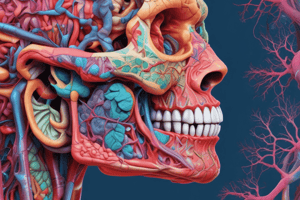Podcast
Questions and Answers
Which of the following factors is NOT a risk associated with healthy aging?
Which of the following factors is NOT a risk associated with healthy aging?
- Depression
- Lack of social participation
- Increased education levels (correct)
- Physical inactivity
What is a key characteristic of disenfranchised grief?
What is a key characteristic of disenfranchised grief?
- It occurs when a person’s grief is not publicly mourned or socially supported. (correct)
- It allows for open acknowledgment of loss.
- It is publicly supported and recognized by society.
- It only relates to the loss of a family member.
Which type of prevention focuses on managing existing chronic conditions?
Which type of prevention focuses on managing existing chronic conditions?
- Primary Prevention
- Tertiary Prevention (correct)
- Secondary Prevention
- Quaternary Prevention
Which of the following best captures social determinants of health?
Which of the following best captures social determinants of health?
What is the role of digital platforms in health?
What is the role of digital platforms in health?
What distinguishes whole-brain death from other forms of death?
What distinguishes whole-brain death from other forms of death?
Which aspect is NOT a characteristic of a persistent vegetative state?
Which aspect is NOT a characteristic of a persistent vegetative state?
Which of the following correctly defines active euthanasia?
Which of the following correctly defines active euthanasia?
What is typically a characteristic of clinical death?
What is typically a characteristic of clinical death?
In the absence of higher brain functions, what is one characteristic of individuals in a persistent vegetative state?
In the absence of higher brain functions, what is one characteristic of individuals in a persistent vegetative state?
What is a critical difference between active and passive euthanasia?
What is a critical difference between active and passive euthanasia?
Which description accurately characterizes brainstem activity in a persistent vegetative state?
Which description accurately characterizes brainstem activity in a persistent vegetative state?
What is typically the outcome for individuals diagnosed with a persistent vegetative state?
What is typically the outcome for individuals diagnosed with a persistent vegetative state?
What is primarily emphasized in hospice care?
What is primarily emphasized in hospice care?
Which term best describes the emotional reactions following a loss?
Which term best describes the emotional reactions following a loss?
What factor is NOT considered a risk in the grieving process?
What factor is NOT considered a risk in the grieving process?
According to the DSM-5, what distinguishes Prolonged Grief Disorder from normal grief?
According to the DSM-5, what distinguishes Prolonged Grief Disorder from normal grief?
Which component is NOT part of the Four Component Model of grief?
Which component is NOT part of the Four Component Model of grief?
Which of the following best describes the process of mourning?
Which of the following best describes the process of mourning?
What is an example of a loss-oriented stressor in the Dual Process Model?
What is an example of a loss-oriented stressor in the Dual Process Model?
Which statement regarding grieving over time is accurate?
Which statement regarding grieving over time is accurate?
What is a common misconception about grief reactions?
What is a common misconception about grief reactions?
Which symptom is characteristic of Prolonged Grief Disorder?
Which symptom is characteristic of Prolonged Grief Disorder?
What is a key eligibility criterion for accessing Voluntary Assisted Dying (VAD) in Victoria?
What is a key eligibility criterion for accessing Voluntary Assisted Dying (VAD) in Victoria?
Which ethical principle opposes euthanasia based on the Hippocratic Oath?
Which ethical principle opposes euthanasia based on the Hippocratic Oath?
Which of the following is NOT one of Kübler-Ross’s stages of grief?
Which of the following is NOT one of Kübler-Ross’s stages of grief?
What effect does death anxiety generally have on younger adults compared to older adults?
What effect does death anxiety generally have on younger adults compared to older adults?
Which component of the final scenario focuses on separation from family and friends?
Which component of the final scenario focuses on separation from family and friends?
What is one potential benefit of death education according to the document?
What is one potential benefit of death education according to the document?
Advance Directives serve the purpose of specifying what?
Advance Directives serve the purpose of specifying what?
How does Cicerelli’s transition model explain death anxiety?
How does Cicerelli’s transition model explain death anxiety?
Which of the following statements about hospice care is true?
Which of the following statements about hospice care is true?
What is a major barrier to completing an Advance Care Plan as noted in the content?
What is a major barrier to completing an Advance Care Plan as noted in the content?
Which of the following strategies best represents primary prevention in public health?
Which of the following strategies best represents primary prevention in public health?
What is the main objective of tertiary prevention?
What is the main objective of tertiary prevention?
Which of the following interventions aligns with quaternary prevention?
Which of the following interventions aligns with quaternary prevention?
Which aspect is the focus of secondary prevention efforts?
Which aspect is the focus of secondary prevention efforts?
What is a key feature of health education as part of primary prevention?
What is a key feature of health education as part of primary prevention?
Study Notes
Primary Prevention
- Aims to prevent diseases or injuries before they occur
- Focuses on reducing risk factors and promoting healthy behaviors
- Examples: Vaccinations, health education programs
Secondary Prevention
- Focuses on early detection and prompt treatment of diseases to halt their progression
- Examples: Screening tests, regular check-ups
Tertiary Prevention
- Aims to manage and reduce the impact of an ongoing illness or injury that has lasting effects
- Examples: Rehabilitation programs, chronic disease management
Quaternary Prevention
- Seeks to avoid over-medicalization and protect patients from unnecessary interventions
- Examples: Avoiding overdiagnosis, ethical medical practices
Studying That Suits You
Use AI to generate personalized quizzes and flashcards to suit your learning preferences.




